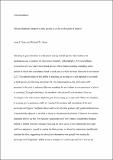Files in this item
African elephants interpret a trunk gesture as a clue to direction of interest
Item metadata
| dc.contributor.author | Smet, Ann Farai | |
| dc.contributor.author | Byrne, Richard William | |
| dc.date.accessioned | 2021-08-16T23:42:04Z | |
| dc.date.available | 2021-08-16T23:42:04Z | |
| dc.date.issued | 2020-08-17 | |
| dc.identifier | 269685541 | |
| dc.identifier | d5613f29-3df4-42c1-8e35-e5bca24936aa | |
| dc.identifier | 85089274221 | |
| dc.identifier | 000563983200008 | |
| dc.identifier | 32810448 | |
| dc.identifier.citation | Smet , A F & Byrne , R W 2020 , ' African elephants interpret a trunk gesture as a clue to direction of interest ' , Current Biology , vol. 30 , no. 16 , pp. R926-R927 . https://doi.org/10.1016/j.cub.2020.06.070 | en |
| dc.identifier.issn | 0960-9822 | |
| dc.identifier.other | ORCID: /0000-0001-9862-9373/work/79226745 | |
| dc.identifier.uri | https://hdl.handle.net/10023/23783 | |
| dc.description | This research was carried out with funding from a departmental studentship from the School of Psychology and Neuroscience of the University of St Andrews, and a Russell Trust Postgraduate Award to A.F.S. | en |
| dc.description.abstract | Orienting to gaze-direction is widespread among animal species, but evidence for spontaneous use of gesture for direction is limited [1]. Remarkably, African elephants (Loxodonta africana) have been found able to follow human pointing, including subtle actions in which the contralateral hand is used, and in which the body silhouette is not broken [2,3]. The natural origin of this ability is puzzling, as the species is not reported to use trunk- or limb-gesture for showing directions [4]. One natural gesture, the ‘periscope-sniff’ presumed to be used to enhance olfactory sampling by an elephant in circumstances of alarm or curiosity [5], might also betray the elephant's direction of focal attention. Here we investigate what information elephants gain from seeing periscope-sniff. When one elephant in a group gave a periscope-sniff, we recorded the location and orientation of the next periscope-sniff given. Elephants that could not see the first gesturer only gestured themselves if immediately adjacent to the first or closer to the presumed stimulus of interest. In contrast, elephants able to see the first signaller's periscope-sniff were often a considerable distance behind it, further from the stimulus. Focusing on these cases, where making the periscope-sniff was apparently caused by seeing the first gesture, we found its orientation significantly matched the first, suggesting that direction information was gained from seeing the periscope-sniff. Elephants’ ability to use a conspecific's periscope-sniff as if it were an ostensive pointing gesture enables them to react to the presence and location of potential dangers. When alarmed, African elephants make a gesture, periscope-sniff, whose primary function is olfaction. Smet and Byrne show that others interpret this gesture as “functional pointing”, using it to locate the direction of another's interest. This may explain how elephants can interpret human pointing without any training, an ability rare among animals. | |
| dc.format.extent | 162765 | |
| dc.language.iso | eng | |
| dc.relation.ispartof | Current Biology | en |
| dc.subject | BF Psychology | en |
| dc.subject | QL Zoology | en |
| dc.subject | Biochemistry, Genetics and Molecular Biology(all) | en |
| dc.subject | Agricultural and Biological Sciences(all) | en |
| dc.subject | NDAS | en |
| dc.subject.lcc | BF | en |
| dc.subject.lcc | QL | en |
| dc.title | African elephants interpret a trunk gesture as a clue to direction of interest | en |
| dc.type | Journal item | en |
| dc.contributor.institution | University of St Andrews. School of Psychology and Neuroscience | en |
| dc.identifier.doi | https://doi.org/10.1016/j.cub.2020.06.070 | |
| dc.description.status | Peer reviewed | en |
| dc.date.embargoedUntil | 2021-08-17 |
This item appears in the following Collection(s)
Items in the St Andrews Research Repository are protected by copyright, with all rights reserved, unless otherwise indicated.

